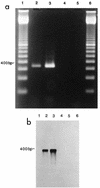Detection and confirmation of Mycoplasma pneumoniae in urogenital specimens by PCR
- PMID: 9431966
- PMCID: PMC124853
- DOI: 10.1128/JCM.36.1.277-280.1998
Detection and confirmation of Mycoplasma pneumoniae in urogenital specimens by PCR
Abstract
Following the isolation of Mycoplasma pneumoniae from urogenital specimens (M. Goulet, R. Dular, J. G. Tully, G. Billows, and S. Kasatiya, J. Clin. Microbiol. 33:2823-2825, 1995), a study was undertaken to confirm the observations by PCR. Specific primers directed to the P1 adhesin gene of M. pneumoniae were used. A total of 300 genital specimens were tested for M. pneumoniae and Mycoplasma genitalium by culture and PCR. Of these, 15 were positive by culture and 17 were positive by PCR for M. pneumoniae. No M. genitalium was detected in any of the specimens by either method. The present study demonstrates that PCR is sensitive and rapid compared to cumbersome culture methods and can be used to detect M. pneumoniae in urogenital specimens in a routine diagnostic laboratory.
Figures


Similar articles
-
Detection of Mycoplasma pneumoniae and Mycoplasma genitalium in clinical samples by polymerase chain reaction.Clin Infect Dis. 1993 Aug;17 Suppl 1:S83-9. doi: 10.1093/clinids/17.supplement_1.s83. Clin Infect Dis. 1993. PMID: 8399944
-
A comparative study of three different PCR assays for detection of Mycoplasma genitalium in urogenital specimens from men and women.J Med Microbiol. 2008 Mar;57(Pt 3):304-309. doi: 10.1099/jmm.0.47498-0. J Med Microbiol. 2008. PMID: 18287292
-
Comparison of first void urine and urogenital swab specimens for detection of Mycoplasma genitalium and Chlamydia trachomatis by polymerase chain reaction in patients attending a sexually transmitted disease clinic.Sex Transm Dis. 2004 Aug;31(8):499-507. doi: 10.1097/01.olq.0000135992.98883.e4. Sex Transm Dis. 2004. PMID: 15273584
-
Polymerase chain reaction as a sensitive and rapid method for specific detection of Mycoplasma pneumoniae in clinical samples.Microbiol Res. 2002;157(2):77-82. doi: 10.1078/0944-5013-00137. Microbiol Res. 2002. PMID: 12002404
-
[Detection of Mycoplasma pneumoniae by using polymerase chain reaction and nonradioactive DNA probes].Rinsho Byori. 1995 Dec;43(12):1251-5. Rinsho Byori. 1995. PMID: 8569036 Review. Japanese.
Cited by
-
Detection of Mycoplasma genitalium by PCR amplification of the 16S rRNA gene.J Clin Microbiol. 2003 Jan;41(1):261-6. doi: 10.1128/JCM.41.1.261-266.2003. J Clin Microbiol. 2003. PMID: 12517858 Free PMC article.
-
Acute respiratory infection due to Mycoplasma pneumoniae: current status of diagnostic methods.Eur J Clin Microbiol Infect Dis. 2010 Sep;29(9):1055-69. doi: 10.1007/s10096-010-0975-2. Epub 2010 Jun 6. Eur J Clin Microbiol Infect Dis. 2010. PMID: 20526788 Free PMC article. Review.
-
Development of a genomics-based PCR assay for detection of Mycoplasma pneumoniae in a large outbreak in New York State.J Clin Microbiol. 2001 Apr;39(4):1385-90. doi: 10.1128/JCM.39.4.1385-1390.2001. J Clin Microbiol. 2001. PMID: 11283060 Free PMC article.
-
Practical recommendations for the drug treatment of bacterial infections of the male genital tract including urethritis, epididymitis and prostatitis.Drugs. 1999 May;57(5):743-50. doi: 10.2165/00003495-199957050-00007. Drugs. 1999. PMID: 10353299 Review.
-
High prevalence of Mycoplasma pneumoniae in intestinal mucosal biopsies from patients with inflammatory bowel disease and controls.Dig Dis Sci. 2001 Nov;46(11):2529-35. doi: 10.1023/a:1012352626117. Dig Dis Sci. 2001. PMID: 11713965
References
-
- Brunner M, Prescott B, Greenberg H, James W D, Horswood R L, Channock R M. Unexpectedly high frequency of antibody to Mycoplasma pneumoniae in human sera as measured by sensitive techniques. J Infect Dis. 1977;135:524–530. - PubMed
-
- Cadieux N, Lebel P, Brousseau R. Use of a triplex polymerase chain reaction for the detection and differentiation of Mycoplasma pneumoniae and Mycoplasma genitalium in the presence of human DNA. J Gen Microbiol. 1993;139:2431–2437. - PubMed
-
- Chewley J P. The polymerase chain reaction. A review of the practical limitations for human immunodeficiency virus diagonosis. J Virol Methods. 1989;25:179–188. - PubMed
-
- Csŭtőrtoki V, Stipkovits L. Nachweis von Mycoplasma pneumoniae Infektionen in weiblichen Geschlechtsorganen. Zentralbl Gynäkol. 1977;99:877–879. - PubMed
MeSH terms
LinkOut - more resources
Full Text Sources
Other Literature Sources

